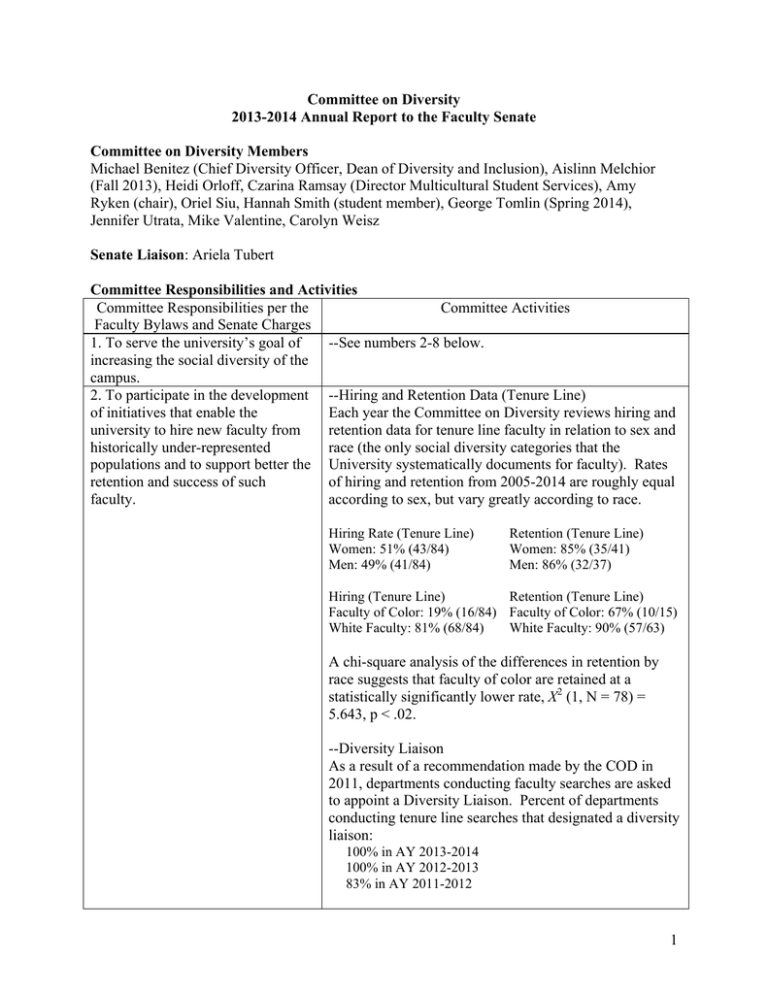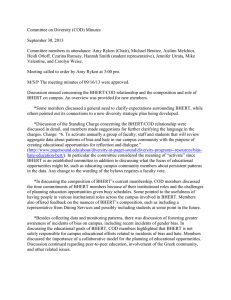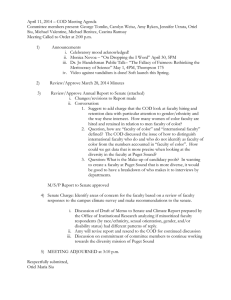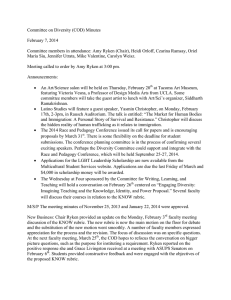
Committee on Diversity
2013-2014 Annual Report to the Faculty Senate
Committee on Diversity Members
Michael Benitez (Chief Diversity Officer, Dean of Diversity and Inclusion), Aislinn Melchior
(Fall 2013), Heidi Orloff, Czarina Ramsay (Director Multicultural Student Services), Amy
Ryken (chair), Oriel Siu, Hannah Smith (student member), George Tomlin (Spring 2014),
Jennifer Utrata, Mike Valentine, Carolyn Weisz
Senate Liaison: Ariela Tubert
Committee Responsibilities and Activities
Committee Responsibilities per the
Committee Activities
Faculty Bylaws and Senate Charges
1. To serve the university’s goal of
--See numbers 2-8 below.
increasing the social diversity of the
campus.
2. To participate in the development --Hiring and Retention Data (Tenure Line)
of initiatives that enable the
Each year the Committee on Diversity reviews hiring and
university to hire new faculty from
retention data for tenure line faculty in relation to sex and
historically under-represented
race (the only social diversity categories that the
populations and to support better the University systematically documents for faculty). Rates
retention and success of such
of hiring and retention from 2005-2014 are roughly equal
faculty.
according to sex, but vary greatly according to race.
Hiring Rate (Tenure Line)
Women: 51% (43/84)
Men: 49% (41/84)
Retention (Tenure Line)
Women: 85% (35/41)
Men: 86% (32/37)
Hiring (Tenure Line)
Retention (Tenure Line)
Faculty of Color: 19% (16/84) Faculty of Color: 67% (10/15)
White Faculty: 81% (68/84)
White Faculty: 90% (57/63)
A chi-square analysis of the differences in retention by
race suggests that faculty of color are retained at a
statistically significantly lower rate, X2 (1, N = 78) =
5.643, p < .02.
--Diversity Liaison
As a result of a recommendation made by the COD in
2011, departments conducting faculty searches are asked
to appoint a Diversity Liaison. Percent of departments
conducting tenure line searches that designated a diversity
liaison:
100% in AY 2013-2014
100% in AY 2012-2013
83% in AY 2011-2012
1
The Committee developed post search follow-up
questions for search chairs and diversity liaisons. Dean
Bartanen solicited responses. The committee will review
responses and make recommendations for better
supporting the work of diversity liaisons.
3. To work with the President, VicePresidents, and the Chief Diversity
Officer concerning diversity
initiatives that can benefit from
faculty presence and leadership, as
needed.
4. To establish liaisons with key
university units including staff and
student diversity groups to assess
strategic needs and work
collaboratively in diversity-related
initiatives, as needed.
5. To work with colleagues to
maintain an educational environment
that welcomes and supports diversity
even as it protects and assures the
rights of academic freedom outlined
in the Faculty Code.
6. To activate annually a group of
faculty, staff and students that will
review aggregate data about patterns
of bias and hate in our campus
community with the purpose of
creating educational opportunities
for reflection and dialogue.
--Curriculum Review (Question 6 in the 5-year Program Review)
See also #5 below regarding the COD recommendation to
and meeting with the Curriculum Committee.
--Amy Ryken served as the Committee on Diversity
representative on the Diversity Advisory Council (DAC).
--The Committee has worked collaboratively with the
Academic Vice President to review hiring and retention
data and to support and review the diversity liaison role.
--The Committee has worked collaboratively with the
Chief Diversity Officer by reviewing and providing
feedback on the goals of BHERT.
-- The Committee collaborates with and works to support
the work of DAC, BHERT, CWTL, the Chief Diversity
Officer, and Multicultural Student Services.
--Amy Ryken met with student leaders during the Student
Diversity Governing Council Retreat to discuss campus
climate survey results and the KNOW proposal. In
addition she participated in the Resident Assistant
Training to discuss LGBTQ issues on campus.
--The COD read and discussed open letters to the campus
written by Puget Sound students Mariana Molina and C.J.
Queirolo. The COD wrote a public response.
--See Charge 3.
--The COD sent a recommendation to the Curriculum
Committee (CC) and Faculty Senate about the CC’s
action to change question #6 in the 5-year
program/curriculum review. Members of the COD met
with the CC to discuss this issue.
-- To enact this charge, each Fall the COD appoints two of
its members to serve on BHERT. Mike Valentine and
Carolyn Weisz served as the COD representatives on
BHERT.
2
7. To report annually to the Faculty
Senate on the committee’s work
related to diversity goals 1-6.
8. Such other duties as may be
assigned to it by the Faculty Senate.
--This document is our annual report.
1. Assess the viability of expanding
the number of faculty HROs
(harassment reporting officers) and
make a recommendation to the
Faculty Senate.
--Charge 1: The COD reviewed and discussed the Report
of the Sexual Assault Work Group (SAWG). The COD
did not assess viability of expanding the number of faculty
HROs because the Chief Diversity Officer is currently in
the process of establishing a campus wide Sexual Assault
Committee that will be charged with reviewing policies
and making recommendations about HRO selection and
role.
2. Identify areas of concern for the
faculty based on a review of faculty
responses to the campus climate
survey and make recommendations
to the senate.
--Charge 2: The COD read and discussed the campus
climate reports shared with the campus this academic year
(e.g., gender, religion, socioeconomic status, political
beliefs, race & ethnicity). The COD asked the Office of
Institutional Research to analyze if minoritized faculty
respondents (by race/ethnicity, sexual orientation, gender,
and/or disability status) had different patterns of reply.
The COD discussed the report provided, identified
patterns, and wrote a report summarizing
recommendations (see Appendix A).
3. Collaborate with the Burlington
Northern group to draft a revised
proposal for a diversity requirement.
--Charge 3: Throughout the academic year the COD
discussed evolving drafts of the Knowledge, Identity, and
Power (KNOW) learning objectives and guidelines and
provided input and feedback to the Burlington Northern
group. Members of the COD also joined the Faculty
Senate for conversations about the KNOW proposal. The
COD unanimously endorsed the KNOW overlay
requirement, which was passed on April 9, 2014 by an
electronic vote of the full faculty (132 yes; 82 no). The
COD discussed the potential role of the committee in
supporting the implementation of the KNOW proposal
and recommended a charge.
Suggested Charges for 2014-2015
Collaborate with the Curriculum Committee to consider strategies for supporting and reviewing
department responses to Question 6
Support implementation of the Knowledge, Identity, and Power (KNOW) proposal
Host discussions about student letters that speak to classroom and campus climate
3
Review hiring and retention data by gender, race/ethnicity, and their intersections, and work with
the Academic Vice President and Dean of Diversity and Inclusion/Chief Diversity Officer to
obtain data on subcategories of faculty of color (e.g., disaggregating by race and international
affiliation)
Continue to collaborate with the Chief Diversity Officer in the development of the sexual assault
committee structure and accessibility of HRO’s.
Support the 2014 National Race and Pedagogy Conference
4
Appendix A
TO:
FM:
Faculty Senate
Committee on Diversity
Michael Benitez, Heidi Orloff, Czarina Ramsay, Amy Ryken (Chair), Oriel Siu, Hannah
Smith (Student Member) George Tomlin, Jennifer Utrata, Mike Valentine, Carolyn
Weisz
RE: Senate Charge: Campus Climate Concerns for Faculty
April 29, 2014
Charge: Identify areas of concern for the faculty based on a review of faculty responses to
the campus climate survey and make recommendations to the senate.
To engage this charge, members of the Committee on Diversity (COD) read the five campus
climate reports released by the Diversity Advisory Council (DAC) this year. These reports
focused on campus climate issues in relation to gender, religion, socio-economic status, political
beliefs, and race/ethnicity. The COD did not have access to the full data set of comments written
by faculty because access to that data is restricted to the Office of Institutional Research and the
DAC to protect the anonymity of survey respondents.
In discussing themes and patterns in the reports a number of concerns about the data collection
and reporting processes were identified:
--The climate survey responses represent majority group responses and reporting empowers the
opinions of faculty in majority groups;
--The COD wondered how the campus can meaningfully solicit and hear the perspectives of
minoritized groups when we do not currently have broad representation, especially of faculty of
color;
--The COD highlighted that a focus on equity and inclusion refers to the process of creating
equivalent outcomes for members of historically underrepresented and oppressed groups, and
assuring that historically underrepresented groups feel they are empowered to participate in
majority culture in ways that shape and redefine campus and community
The COD asked the office of Institutional Research to re-analyze the climate survey data to
determine if the views of faculty differed based on race/ethnicity, gender, sexual orientation, and
disability status. The COD reviewed the report and noted differences in response patterns. A
significant and overarching pattern across these four facets of identity/social participation is that
faculty who identify with a minoritized group are more likely to report feeling excluded,
silenced, ignored, discriminated against or harassed, even subtly as a result of minoritized group
belonging. Below we share data from the report:
Race/Ethnicity: Whereas less than 1% (n = 1) of White faculty respondents reported that they felt
excluded, silenced, ignored, discriminated or harassed, even subtly, as a result of their
race/ethnicity, 29% (n = 2) of Asian faculty and 50% (n = 2) of Hispanic faculty reported that
they felt excluded, silenced, ignored, discriminated against, or harassed, even subtly, as a result
of their race/ethnicity. It is important to note that no African American faculty (n = 3), American
Indian faculty (n = 1), or faculty of two or more races (n = 1) responded to this question on the
survey.
5
Gender: Of the 86 female faculty respondents, 28% (n = 24) reported that they felt excluded,
silenced, ignored, discriminated against, or harassed, even subtly as a result of their gender,
compared to only 4% (n = 3) of male faculty respondents. Faculty members who self identify as
female are also more likely to report feeling marginalization based on age (17.4% (n=15) of
female faculty compared to 9.6% (n=8) of male faculty) and race/ethnicity (5.8% (n=5) of female
faculty compared to 0% of male faculty).
Sexual Orientation: Fifteen percent (n = 2) of gay/lesbian faculty respondents reported feeling
excluded, silenced, ignored, discriminated against, or harassed, even subtly, as a result of their
sexual orientation, and no other faculty respondents reported this.
Disability Status: Of the 11 faculty respondents who reported having a physical or learning
difference on the 2012 Climate Survey, 18% (n = 2) reported that they felt excluded, silenced,
ignored, discriminated against or harassed, even subtly, as a result of their disability status
(compared to the 0% of the 164 faculty who reported not having a physical or learning
difference).
While the numbers of faculty who self identify as members of minoritized groups and who report
feeling marginalized are small these findings are important to note and attend to precisely
because Puget Sound has not yet achieved structural diversity as articulated in the Diversity
Strategic Plan.
Each year the Committee on Diversity reviews hiring and retention data in relation to sex and
race. Rates of hiring and retention from 2005-2014 are roughly equal according to sex, but vary
greatly according to race.
Hiring (Tenure Line)
Retention (Tenure Line)
Women: 51% (43/84)
Women: 85% (35/41)
Men: 49% (41/84)
Men: 86% (32/37)
Hiring (Tenure Line)
Faculty of Color: 19% (16/84)
White Faculty: 81% (68/84)
Retention (Tenure Line)
Faculty of Color: 67% (10/15)
White Faculty: 90% (57/63)
A chi-square analysis of the differences in retention by race suggests that faculty of color are
retained at a statistically significantly lower rate, X2 (1, N = 78) = 5.643, p < .02. The COD was
unable to do a chi-square analysis of differences in hiring rates because in order to do so we
would need to identify hiring rates nationally for comparative analysis.
The Faculty Bylaws charge the Committee on Diversity (Section 6 H.b.2) to participate in the
development of initiatives that enable the university to hire new faculty from historically underrepresented populations and to support better the retention and success of such faculty. In
considering how to summarize the reports, members of the COD strongly expressed how the one
key issue with respect to diversity on campus is achieving racial diversity in faculty hiring.
6
Below is an outline of the goals of hiring a diverse applicant pool as articulated in the Diversity
Strategic Plan.
Goal 1: We will increase the recruitment and retention of students, staff, and faculty from
underrepresented minority groups.
Underrepresented minority: Racial or ethnic groups that have been historically
minoritized and/or are typically underrepresented in American higher education including
people of Black/African-American, Latin/Hispanic, and Native American heritage.
Goal 2: We will create a campus environment that fully welcomes and supports social
diversity.
Social diversity: Characteristics that could cause groups or individuals to be minoritized
and/or systematically excluded from full participation in higher education, including age,
disability, gender, race/ethnicity, religion/spiritual tradition, sexual orientation, job status
or socioeconomic class, personal appearance, and political beliefs.
Literature in higher education points to key findings about hiring and retaining underrepresented
and minoritized groups and what institutions can do to address challenges with faculty diversity.
Findings indicate that assuring underrepresented and minority faculty are represented in hiring
processes and practices is important to achieving diversity in recruitment. With respect to hiring,
findings indicate that institutions are not doing enough to assure accountability in hiring
practices even though literature points to the importance of formalizing and centralizing diversity
as a hiring component. This requires moving beyond nice intentions and individual perspectives
about “best candidates” to situating departmental and institutional hiring practices in relation to
best practices literature. According to the research, successfully recruiting of faculty of color is
informed by a combination of the following:
1. Representation of key diversity personnel on search committees,
2. Presence of underrepresented faculty and staff of color in the community,
3. Development of faculty learning communities focused on cultural/community needs,
4. Faculty mentorship opportunities available, and;
5. An institution’s ability to create and maintain department climates that encourage the
fair and equitable treatment of pre-tenure faculty of color.
In addition to the findings listed above about hiring underrepresented and minority faculty of
color, much literature also exists that focuses on retention. Both, recruitment and retention need
to be considered as different but highly connected themes to be addressed to the success of
assuring a diverse faculty through a lens of equity and inclusion. Hence, both goals listed above
require us to consider them in integration. Working to achieve our goals will require that
institutionally we work towards creating the welcoming, inclusive, and equitable campus climate
necessary to achieve recruitment and retention of faculty for historically marginalized groups.
Similarly, intentionally recruiting and retaining a representation of diverse faculty is a significant
element to cultivating a welcoming campus community that addresses the challenges faced by
underrepresented and minoritized faculty, staff, and students of color.
7
The Committee on Diversity poses the following questions:
--Is the Faculty committed to the goal of diversifying the faculty? If not, why not?
--Where does commitment to diversifying the faculty exist, and what might promote a broader
commitment?
--What incentives might be provided to faculty of color to provide time to build community (as
defined/outlined by the needs and challenges of faculty of color), to focus on teaching and/or to
develop a research agenda (e.g., reduced teaching load, research funding, intentional mentorship,
etc.)?
--Given the decentralized nature of hiring, how might departments be held accountable for goals
articulated in the diversity strategic plan?
The Committee on Diversity recommends that the COD collaborate with the Academic Vice
President, the Dean of Diversity and Inclusion/Chief Diversity Officer, and the Office of
Institutional Research to determine an intentional plan to:
--Conduct interviews with faculty of color to better understand
1) What would have been important factors in hiring?
2) What might community/belonging look like?
3) What elements of the environment are welcoming and not welcoming?
4) What aspects of your job provide or impede satisfaction?
Members of the COD also discussed their concern about the importance of intentional
consideration of confidentiality in the way that information is collected and disseminated.
--Consider the decentralized nature of hiring
1) How might departments be held accountable for goals articulated in the diversity strategic
plan?
2) What resources or information would help departments to achieve these goals?
References
Turner, C. S. V. (2002). Diversifying the faculty: A guidebook for search committees.
Washington, D.C.: Association of American Colleges and Universities
Turner, C. S. V., Gonzalez, J. C., & Wood, J. L. (2008). Faculty of color in academe: What 20
years of literature tells us. Journal of Diversity in Higher Education, 1(3), 39-168.
Williams., D. A. (2013). Strategic diversity leadership: Activating change and transformation in
higher education. Sterling, VA: Stylus.
Sorcinelli, M. D., Austin, A., Eddy, P. L., and Beach, A. (2006). Creating the Future of Faculty
Development. Bolton, MA: Anker Publishing,
Umbach, P. “The Contribution of Faculty of Color to Undergraduate Education.” Research in
Higher Education, 47 (3), 2006.
Smith, J. W., and Calasanti., T. “The Influences of Gender, Race, and Ethnicity on Workplace
Experiences of Institutional and Social Isolation: An Exploratory Study of University Faculty.”
Sociological Spectrum, 25, 2005.
8



